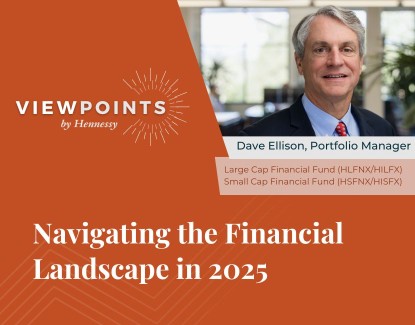A Healthy Banking Industry
In the following commentary, Portfolio Managers Dave Ellison and Ryan Kelley discuss the reasons behind the selloff at the end of 2018, the outlook for short-term interest rates, and what they believe is the healthy state of the banking industry going into 2019.
-
 David EllisonPortfolio Manager
David EllisonPortfolio Manager -
 Ryan C. Kelley, CFAChief Investment Officer and Portfolio Manager
Ryan C. Kelley, CFAChief Investment Officer and Portfolio Manager
What caused the selloff in the Financials sector at the end of 2018?
During the fourth quarter of 2018, investors were concerned that rising interest rates could dampen economic growth and drive an upswing in loan defaults in the banking industry. Federal Reserve Chairman Powell indicated that the steady increases in interest rates would continue. With the yield curve close to flat, markets concluded that the risk of the Fed “overshooting”, or raising rates too much, was high. In response, bank stocks, and equities generally, sold off.
We believe investors reacted hastily at the end of 2018. Reports from the banking industry do not signal an imminent slowdown, with asset quality strong through the first three quarters of 2018 and earnings reports showing continued improvement in the fourth quarter. Recent economic reports on job creation and industrial activity have also shown that the economy maintained a steady pace of growth in the final quarter of 2018. We believe investors will continue to regain confidence in the strength of the economy and the banking industry over the next few months.
What is your outlook for short-term interest rates and how will it impact the banks?
Partly in response to weakness in financial markets, the Fed indicated in December 2018 that it will cease further gradual rate increases and will maintain a “patient” stance on future moves. As a result, we believe the Fed will keep short-term rates at the current 2.5% rate for most of 2019.
Banks earnings have benefited from rising rates, and net interest margins have been rising steadily, reaching 3.45% in the third quarter of 2018 up from a low of 3.02% in the third quarter of 2015. Even though rates may remain flat for a period, we believe that banks can continue to see net interest margins expand incrementally as older loans reprice at higher rates.
What is your outlook for large-cap financials?
We believe large-cap banks look attractive.
1. Fundamentals for the banking industry remain strong. Loan growth is moderate, and profitability levels are high. Return on assets averaged 1.4% in the third quarter of 2018 compared with 0.9% in 2011. Asset quality, as mentioned above, is strong.
2. Large-cap bank valuations look compelling, with average price to earnings multiples on forward earnings of 10x compared with 17x for the S&P 500 Index.
3. We believe profit margins can expand as a result of cost control, an area where banks continue to make progress. Commercial banks trimmed payrolls in 2018 for the first time since 2014, and non-interest costs as a percentage of revenue (the efficiency ratio) fell from 59.1% at the end of 2017 to 55.8% in third quarter 2018. Banks have done well over the longer term also, lowering their efficiency ratio by over seven percentage points since 2013.
4. Banks have been returning excess capital to shareholders in the form of higher dividends and share buybacks.
We also have a positive outlook on diversified financial companies.
1. We believe diversified financial companies such as Visa, PayPal, Charles Schwab, and credit rating agency Moody’s have excellent long-term prospects for growth.
2. Diversified financial companies’ operations are relatively insulated from the movement of interest rates and other cyclical considerations, and demand for their products and services continues to grow.
3. These companies look particularly attractive following a significant drop in valuations since the beginning of 2018.
Approximately 40% of the Hennessy Large Cap Financial Fund was invested in diversified financial companies as of December 31, 2018.
Would you please discuss potential drivers of small-cap bank stocks?
The banking industry continues to consolidate, which tends to benefit small- and mid-cap banks both as acquirers and acquisition targets. Merger and acquisition (M&A) activity was strong in 2018 with 266 transactions, making 2018 the sixth straight year when the number of deals exceeded 250. Valuation multiples paid by acquiring companies have been rising each year.
In addition, small- and mid-cap banks continue to grow their earnings: Since the first quarter of 2016, they have generated annual earnings growth of 17%.
How well are banks protected against another economic downturn?
We believe the banks and the financial industry as a whole are better positioned for an economic downturn than in 2008. New regulations have lowered bank balance sheet leverage and management teams have been paying close attention to interest rate, credit, and liquidity risks.
- In this article:
- Financials
- Small Cap Financial Fund
- Large Cap Financial Fund
You might also like
-
 Portfolio Perspective
Portfolio Perspective
Large Cap Financial FundSmall Cap Financial FundSeeking Innovation in the Financials Industry
 David EllisonPortfolio Manager
David EllisonPortfolio Manager Ryan C. Kelley, CFAChief Investment Officer and Portfolio ManagerRead the Commentary
Ryan C. Kelley, CFAChief Investment Officer and Portfolio ManagerRead the CommentaryPortfolio Managers Dave Ellison and Ryan Kelley discuss what’s driving performance in the Hennessy Large Cap Financial Fund, how tariff increases affect banks, the interest rate environment, and the opportunities in financials.
-
 Viewpoint
ViewpointNavigating the Financial Landscape in 2025
 David EllisonPortfolio ManagerWatch the Video
David EllisonPortfolio ManagerWatch the VideoHennessy Funds Portfolio Manager Dave Ellison discusses the key drivers behind the financial sector's strong performance in 2024, the impact of potential rate cuts and regulatory changes, and the evolving landscape of banking in 2025. He also explores the challenges and opportunities facing both large and small banks, the role of AI, and the critical risks to watch, from traditional credit concerns to transformative technological shifts.
-
 Portfolio Perspective
Portfolio Perspective
Large Cap Financial FundSmall Cap Financial FundWhat’s Next for Financials After 2024 Outperformance?
 David EllisonPortfolio Manager
David EllisonPortfolio Manager Ryan C. Kelley, CFAChief Investment Officer and Portfolio ManagerRead the Commentary
Ryan C. Kelley, CFAChief Investment Officer and Portfolio ManagerRead the CommentaryPortfolio Managers Dave Ellison and Ryan Kelley discuss what drove 2024 performance in the Financials sector and drivers for potential earnings growth in a lighter regulatory and declining interest-rate environment.
